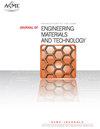Mar M 509短周期热处理后的组织演变和室温力学性能。
IF 1.9
4区 材料科学
Q3 ENGINEERING, MECHANICAL
Journal of Engineering Materials and Technology-transactions of The Asme
Pub Date : 2023-08-25
DOI:10.1115/1.4063257
引用次数: 0
摘要
钴基高温合金Mar M 509以其耐高温氧化和热腐蚀性而闻名,它是通过激光粉末床熔融(LPBF)处理的。基于两个构建方向(纵向(L)和横向(T)),比较了Mar M 509在印刷态(as-P)和热处理态(HT)下的微观结构和力学性能,以建立与热处理的结构-性能联系。As-P条件显示出明显的细胞微结构(500-600nm),其中50-60nm的碳化物颗粒装饰细胞边界。纵向(L)结构具有晶粒纵横比为4的柱状晶粒(沿主轴8-35μm),而横向(T)取向表现出等轴双峰微观结构(5-10μm和15-25μm晶粒尺寸)。L具有强烈的织构。室温下L和T的机械性能不同;与L(489±18HV)相比,T(569±12HV)的硬度高出15%,屈服强度(YS)高出34%,但伸长率比L低30%。在1250°C的短热处理循环后,焊道结构和细胞边界破裂。L(沿主轴25-33μm)和T取向(5-42μm)都经历晶粒生长,碳化物粗化(250-350 nm)。热处理后,位错密度降低,表明再结晶;基体晶格参数降低,表明溶质贫化有助于碳化物富集。屈服强度从L的860MPa下降到740MPa,从T的1150MPa下降到840MPa,延展性从L的14%上升到23%。本文章由计算机程序翻译,如有差异,请以英文原文为准。
Microstructural Evolution and Room Temperature Mechanical Properties in Additively Manufactured Mar M 509 with Short Cycle Heat Treatment.
The Co-based superalloy Mar M 509, known for its high-temperature oxidation and hot corrosion resistance, is processed via laser powder bed fusion (LPBF). Microstructure and mechanical properties of Mar M 509 in as-printed (As-P) and heat-treated (HT) states are compared based on two build orientations (longitudinal (L) and transverse (T)) to establish structure-property links with heat treatment. The As-P condition displays a distinct cellular microstructure (500-600 nm) with 50-60 nm carbide particles adorning cell boundaries. Longitudinal (L) build has columnar grains (8-35 μm along major axis) with a grain aspect ratio of 4, while transverse (T) orientation exhibits equiaxed, bimodal microstructure (5-10 μm and 15-25 μm grain sizes). Strong <001> texture is noted in L. Mechanical properties at room temperature differ between L and T; T (569±12HV) has 15% higher hardness compared to L (489±18HV) and 34% higher 0.2% yield strength (YS), but 30% lower elongation than L. Post a short heat treatment cycle at 1250°C, weld bead structure and cell boundaries break down. Both L (25-33 μm along major axis) and T orientations (5-42 μm) experience grain growth, and carbides coarsen (250-350 nm). Post-heat treatment, dislocation density decreases, indicating recrystallization; lattice parameter of matrix reduces, implying solute depletion contributing to carbide enrichment. Yield strength drops from 860 MPa to 740 MPa in L and from 1150 MPa to 840 MPa in T, with ductility rising from 14% to 23% in L.
求助全文
通过发布文献求助,成功后即可免费获取论文全文。
去求助
来源期刊
CiteScore
3.00
自引率
0.00%
发文量
30
审稿时长
4.5 months
期刊介绍:
Multiscale characterization, modeling, and experiments; High-temperature creep, fatigue, and fracture; Elastic-plastic behavior; Environmental effects on material response, constitutive relations, materials processing, and microstructure mechanical property relationships

 求助内容:
求助内容: 应助结果提醒方式:
应助结果提醒方式:


